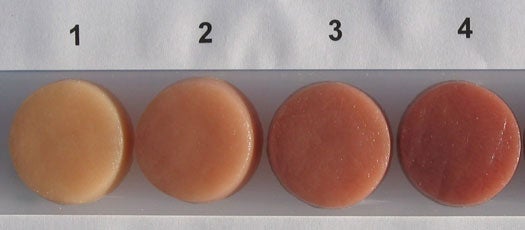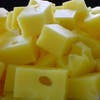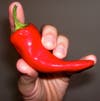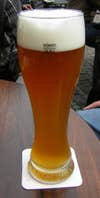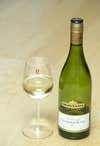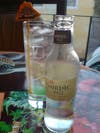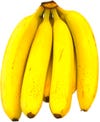Taste is a highly subjective thing. But when science gets involved, things have to be measured, and the measurements must be exact.
Here are 11 ways that food is precisely measured. Bitterness can be determined based on a specific scale, and the amount of sucrose in a solution can be easily calculated. Some others are a little more esoteric: stretching cheese to measure its texture; determining the color of a beer based on how much light passes through it; testing the strength of coffee.
_
Click to launch the photo gallery._
Check out the gallery for the full collection.
Cheese Stretchiness
The Utah State University Stretch Test was developed in 2002 to determine the stretchiness, meltability, and viscosity of various cheeses; researchers analyze samples with everything from a helical viscometer to the good-old “pizza-fork test.” After being tempered in a bath at precise temperatures, cheeses are measured according to three scales. Melt strength (Fm) is defined as the maximum force required when the cheese was pulled; stretch length (SL) is measured in centimeters, and stretch quality (SQ) quantifies the amount of cheese you get when you pull a certain distance.
Decibels of Crispiness
Scientists can determine with uncanny accuracy just how much your snack is annoying the person next to you: The crispiness of apples and other foods has been measured according to the volume of sound produced when a person takes a bite. Coxs Orange Pippin apples stored by different methods were recorded and analyzed in a 2000 experiment. One test found a 90-percent correlation between how crisp eaters thought an apple was and the volume of the sound generated while eating.
Loin Color
For consumers judging a piece of meat behind plastic wrap, there’s not much to go on besides color. That’s why researchers developed a six-point gradient scale for pork, using Japanese resin molds. (A three, four, or five is best for the Japanese market.) An instrument called a color meter is also used to measure the light reflected off differently colored cuts, producing a more objective measurement.
Chili Pepper Heat
The Scoville scale indicates the amount of mouth-burning capsaicin present in foods, and it does it with great precision: the scale goes from zero (bell peppers) all the way to police-grade pepper spray and the feared Trinidad Moruga Scorpion pepper (1.5 million to 2 million). It’s stood the test of time, too, first devised in 1912 and still used today, albeit with more modern chemical testing techniques now rather than the human taste-test it required at first.
Beer Color
Exactly how dark a beer do you want? The Standard Reference Method can say with scientific precision the color of a beer, placing it on a gradient with others. A certain wavelength of light is passed through 1 cm of beer and the amount of light lost is measured. A 2, say, puts you in the vicinity of a light yellow pale lager; an imperial stout, by contrast, goes all the way to 70.
Ripeness of Wine Grapes
The Oechsle Scale, named for German Ferdinand Oechsle (1774-1852), measures the density of grape must, the raw batch of grape mix fermented into wine. Getting the number is a little complicated: Take one litre of the must at 20 degrees celsius. Compare its mass to the mass of one litre of water. Every gram of difference between the two masses is one degree Oechsle. The scale can go all the way up to grapes affected by noble rot and packed with sugar — which, if plucked and tested correctly, could mean an especially fine and sweet wine.
Sugar Concentration
Brix is the scale used to determine the sugar content in fruits, vegetables, juices, wines, soft drinks, and honey. One gram of sucrose in 100 grams of solution is equal to one degree Brix. It’s similar to a few other units of measurement, including the Plato scale, which uses a similar method to determine the density of beer wort.
Total Dissolved Solids
Coffee is made of soluble material dissolved in water. Hence, the primary measurement used to determine the perfection of your cup of joe is total dissolved solids (TDS). It’s the same metric by which governments and scientists determine the purity of water and contaminated soil — everything that isn’t pure H2O is dissolved solids. So for coffee, the gauge lets brewers know how concentrated their product is. Too low a TDS count and the brew is watery; too high and it’s overly strong.
Bitterness
The chemical quinine is generally used as a base to determine the bitterness of other solutions. Quinine hydrochloride, found in tonic water, is set on an index at one, the lowest of the scale, while others are raised on the index based on how quickly humans can detect it in a substance. The index goes up to 1,000, for the bitterest substance, denatonium, which is added to poisonous solutions to keep anyone from drinking them by mistake.
Banana Equivalent Dose
Most organic material, including fruit, contains a little bit of radiation. The banana equivalent dose — a whimsical unit used by biologists — is defined as the amount of radiation a person is exposed to when he or she eats a banana. But before you organize a ban on bananas, don’t worry: it’s not much, and it’s definitely not enough to be harmful.
Poise
How do you measure how viscous a substance is? The poise is a unit of viscosity equal to one dyne-second per square centimeter, or one tenth of a pascal-second. Basically, it’s the flowability of a liquid, with water at being equal to about one centipoise, or 0.01 poises. The scale puts honey at 2,000 centipoise, molasses at 5,000, and lard at a whopping 10,000.
